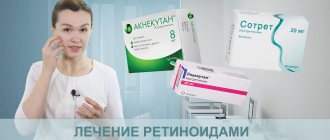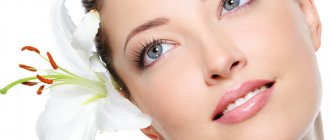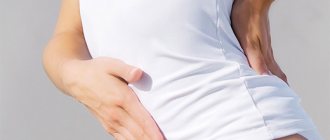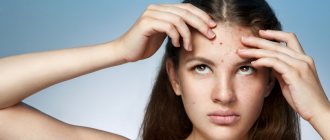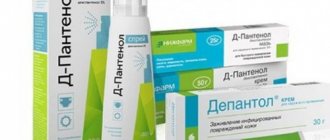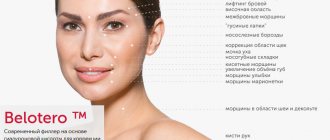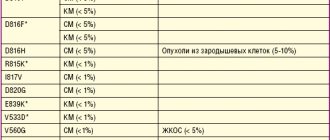Roaccutane®
Pregnancy is an absolute contraindication for therapy with Roaccutane®. If pregnancy occurs, despite warnings, during treatment or within a month after the end of therapy, there is a very high risk of giving birth to a child with severe malformations.
Isotretinoin is a drug with a strong teratogenic effect. If pregnancy occurs during a period when a woman takes isotretinoin orally (at any dose and even for a short time), there is a very high risk of giving birth to a child with developmental defects.
Roaccutane® is contraindicated in women of childbearing potential unless the woman's condition meets all of the following criteria:
- she must have severe acne that is resistant to conventional treatments;
- she must accurately understand and follow the doctor’s instructions;
- she must be informed by the doctor about the danger of pregnancy during treatment with Roaccutane® within one month after it and urgent consultation if pregnancy is suspected;
- she should be warned about the possible ineffectiveness of contraceptives;
— she must confirm that she understands the essence of the precautionary measures;
- she must understand the need and continuously use effective methods of contraception for one month before treatment with Roaccutane®, during treatment and for a month after its completion (see section “Interaction with other drugs”); it is advisable to use 2 different methods of contraception at the same time, including barrier;
- she must have received a negative result from a reliable pregnancy test within 11 days before starting the drug; A pregnancy test is strongly recommended monthly during treatment and 5 weeks after the end of therapy;
- she should start treatment with Roaccutane® only on the 2-3 day of the next normal menstrual cycle;
- she must understand the need for mandatory visits to the doctor every month;
- when being treated for a relapse of the disease, she must constantly use the same effective methods of contraception for one month before starting treatment with Roaccutane®, during treatment and for a month after its completion, as well as undergo the same reliable pregnancy test;
- She must fully understand the need for precautions and confirm her understanding and desire to use reliable methods of contraception as explained to her by the doctor.
Use of contraception as directed above during treatment with isotretinoin should be recommended even in women who do not routinely use contraception due to infertility (except in patients who have had a hysterectomy), amenorrhea, or who report not being sexually active.
The doctor must be sure that:
— the patient has a severe form of acne (nodulocystic, conglobate acne or acne with a risk of scarring); acne that does not respond to other types of therapy;
- a negative result from a reliable pregnancy test was obtained before starting the drug, during therapy and 5 weeks after the end of therapy; the dates and results of the pregnancy test must be documented;
- the patient uses at least 1, preferably 2 effective methods of contraception, including a barrier method, for one month before starting treatment with Roaccutane®, during treatment and for a month after its completion;
— the patient is able to understand and fulfill all of the above requirements for pregnancy protection;
— the patient meets all of the above conditions.
Pregnancy test
According to current practice, a pregnancy test with a minimum sensitivity of 25 mIU/ml should be performed in the first 3 days of the menstrual cycle:
Before starting therapy:
— To exclude possible pregnancy, before starting contraception, the result and date of the initial pregnancy test must be recorded by a doctor. In patients with irregular menstruation, the timing of a pregnancy test depends on sexual activity and should be performed 3 weeks after unprotected intercourse. The doctor should inform the patient about contraceptive methods.
— A pregnancy test is carried out on the day of prescription of the drug Roaccutane® or 3 days before the patient’s visit to the doctor. The specialist should record the test results. The drug can only be prescribed to patients receiving effective contraception for at least 1 month before starting therapy with Roaccutane®.
During therapy:
— The patient must visit the doctor every 28 days. The need for monthly pregnancy testing is determined in accordance with local practice and taking into account sexual activity and previous menstrual irregularities. If indicated, a pregnancy test is performed on the day of the visit or three days before the visit to the doctor, the test results must be recorded.
End of therapy:
- 5 weeks after the end of therapy, a test is performed to exclude pregnancy.
A prescription for Roaccutane® for a woman capable of childbearing can be issued only for 30 days of treatment; continuation of therapy requires a new prescription of the drug by a doctor. It is recommended that a pregnancy test, writing a prescription and receiving the drug be carried out on the same day.
The drug Roaccutane® should be dispensed at the pharmacy only within 7 days from the date of issuing the prescription.
To help physicians, pharmacists and patients avoid the risk of fetal exposure to Roaccutane®, the company aims to warn about the drug's teratogenicity and emphasize the absolute mandatory use of reliable contraceptive measures for women of childbearing age. The program contains the following materials:
for doctors:
— a doctor’s guide to prescribing Roaccutane® to women
— informed consent form for the patient
— form for recording the prescription of the drug to women for the patient:
— patient information brochure
- what you need to know about contraception
- for the pharmacist:
— a guide for the pharmacist on the dispensing of the drug Roaccutane®.
Full information about teratogenic risk and strict adherence to measures to prevent pregnancy should be provided to both men and women.
For male patients
Existing data indicate that in women, exposure to the drug from the semen and seminal fluid of men taking Roaccutane® is not sufficient to cause the teratogenic effects of Roaccutane®.
Men should exclude the possibility of other persons, especially women, taking the drug.
If, despite the precautions taken, pregnancy does occur during treatment with Roaccutane® or within a month after its end, there is a high risk of very severe fetal malformations (in particular, from the central nervous system, heart and large blood vessels) . In addition, the risk of spontaneous miscarriage increases.
If pregnancy occurs, therapy with Roaccutane® is discontinued. The advisability of maintaining it should be discussed with a doctor specializing in teratology. Severe congenital malformations of the fetus in humans associated with the use of Roaccutane® have been documented, including hydrocephalus, microcephaly, cerebellar malformations, anomalies of the external ear (microtia, narrowing or absence of the external auditory canal), microphthalmia, cardiovascular anomalies (tetrad Fallot, transposition of the great vessels, septal defects), malformations of the face (cleft palate), thymus gland, pathology of the parathyroid glands. Because isotretinoin is highly lipophilic, it is very likely that it passes into breast milk. Due to possible side effects, Roaccutane® should not be prescribed to nursing mothers.
The use of isotretinoin for the correction of wrinkles –
But the retinoid isotretinoin can be used not only systemically (orally).
There are a small number of drugs with isotretinoin for external use, which were initially used exclusively for the treatment of acne and pimples, but later these drugs began to be used to correct the symptoms of photoaging. As in the case of the retinoid tretinoin, preparations with isotretinoin also help to increase skin elasticity and reduce the depth of wrinkles. What effects do external forms of isotretinoin cause in the skin:
- Peeling effect - the thickness of the superficial stratum corneum of the epidermis decreases (due to exfoliation of dead skin cells). This evens out skin tone and texture, leaving skin looking more youthful and radiant—like you've had a few superficial chemical peels.
- Increasing the thickness of the deep layers of the epidermis - isotretinoin affects stem keratinocytes located at the basement membrane, increasing the rate of their division and differentiation. This leads to an increase in the thickness of the deep layers of the epidermis, consisting of living keratinocytes. As a result, the hydrophobicity of the epidermis increases, which contributes to less evaporation of moisture from the surface of the skin. In addition, it prevents skin photoaging.
- Stimulation of the production of collagen and hyaluronic acid - isotretinoin affects not only the epidermis, but also the dermis. It promotes the proliferation (reproduction) of fibroblasts, and also significantly stimulates their activity, which leads to an increase in their production of collagen, elastin and endogenous hyaluronic acid. This leads to an increase in the thickness of the dermis, a decrease in the depth of wrinkles, and an increase in skin elasticity. It is known that thicker skin is less susceptible to the aging process.
Optimal concentrations of external forms of Isotretinoin –
There are a number of clinical studies where scientists have determined the optimal concentration of isotretinoin for the treatment of photoaging.
1) “Armstrong RB, Lesiewicz J, Harvey G et al. Clinical panel assessment of photodamaged skin treated with isotretinoin using photographs. Arch Dermatol 1992; 128:352–6.” 2) “Sendagorta E, Lesiewicz J, Armstrong RB. Topical isotretinoin for photodamaged skin. J Am Acad Dermatol 1992; 27:S15–18.”
In these studies, the concentration of Isotretinoin was increased from 0.05% at the beginning of the study to 0.1% at the end of the study. Despite the increase in concentration, the drug was well tolerated by patients without causing significant skin irritation. As a result of the treatment of photoaging skin with 0.1% Isotretinoin, the skin condition gradually improved throughout the 36-week treatment, and a decrease in the depth of wrinkles and fine lines was achieved.
3) The study “Maddin S, Lauharanta J, Agache P et al. Isotretinoin improves the appearance of photodamaged skin: results of a 36-week, multicenter, double-blind, placebo-controlled trial. J Am Acad Dermatol 2000; 42:56–63.” In this study, a combination of 0.05% Isotretinoin plus SPF sunscreen was used to treat photoaging. The result was that the condition of skin with visible photodamage was significantly improved, which was recorded using profilometry.
Conclusions: if you are interested in preventing skin photoaging, it is best to use a 0.05% concentration in combination with sunscreen. If you want to achieve an increase in skin elasticity and a decrease in the depth of wrinkles, then the main treatment should be carried out using a 0.1% concentration (it is better to use a 0.05% concentration for the first month so that the skin gets used to retinoids).
Isotretinoin has a delayed effect - it will take at least 8-12 weeks before you notice any positive changes, although the first positive effect associated with improved skin tone and texture will be noticeable after 4-6 weeks. It must be admitted that abroad isotretinoin is used for the correction of photoaging much less frequently than other types of retinoids - tretinoin or pure retinol.
Preparations with isotretinoin for external use –
- “Retinoic ointment” (Fig. 8) – is available with an isotretinoin concentration of 0.05% or 0.1%. The cost will be from 300 rubles for a 15 g tube. About a tenth of the volume is ethyl alcohol, so you should not use this drug if you have dry and/or sensitive skin. In principle, the manufacturer writes in this regard that this drug is intended for the treatment of acne in patients with oily skin.
- "Retasol" (Fig. 9) - is a solution for external use, with an isotretinoin concentration of 0.025%. But keep in mind that this drug also contains alcohol, but in less quantity than retinoic ointment. In addition, the drug contains propylene glycol, which may cause irritation in patients with sensitive skin. Cost from 400 rubles per 50 ml bottle.
Isotretinoin: instructions for use
These instructions for using the drug are equally suitable for the treatment of acne and for facial skin rejuvenation techniques, for which information will be given below.
1) Wash your face thoroughly with a mild cleanser. 2) It is advisable to wait 20-30 minutes for the skin to dry thoroughly. 3) Squeeze out a pea-sized amount of the preparation and rub evenly. 4) Avoid contact of the drug with the mucous membranes of the eyes, lips, and nose. 5) After applying the drug, wash your hands thoroughly. 6) Use Isotretinoin 1 time per day (before bed). 7) Be patient - you will see the first results after 4 weeks when treating acne, and after 8-12 weeks for skin rejuvenation. The average treatment duration is 16-24 weeks for acne, and up to 36 weeks for improving the appearance and firmness of the skin.
Features of application –
Do not use more of the drug than recommended or more often than prescribed, because This will not speed up the effect, but will cause more redness, peeling and itching. In addition, isotretinoin should not be used if the skin in the area of application is damaged. During the treatment period, it is necessary to avoid exposure to sunlight, especially during periods of high solar activity (otherwise you may get hyperpigmentation of the treated skin areas).
Always apply sunscreen with SPF 50 before going outside. In summer, wear wide-brimmed hats to shield your face from the sun.
Side effects of topical forms of isotretinoin -
It should be noted that isotretinoin may affect different people differently. In most patients they are completely absent or mild. The most common side effects are redness, dryness, flaking, itching and burning of the skin, and increased sensitivity to sunlight. You can see the side effects from the use of retinoids in Fig. 10-11.
We hope that our article: Acnecutane and Roaccutane reviews was useful to you!
Sources:
1. Higher medical education of the author of the article, 2. Textbook on dermatology “Fitzpatrick's Dermatology” (8th edition), 3. American Academy of Dermatology (USA), 4. “Isotretinoin in the treatment of acne” (Tlish M., Shavilova M.), 5. “Cosmetic dermatology” (Bauman L.).
